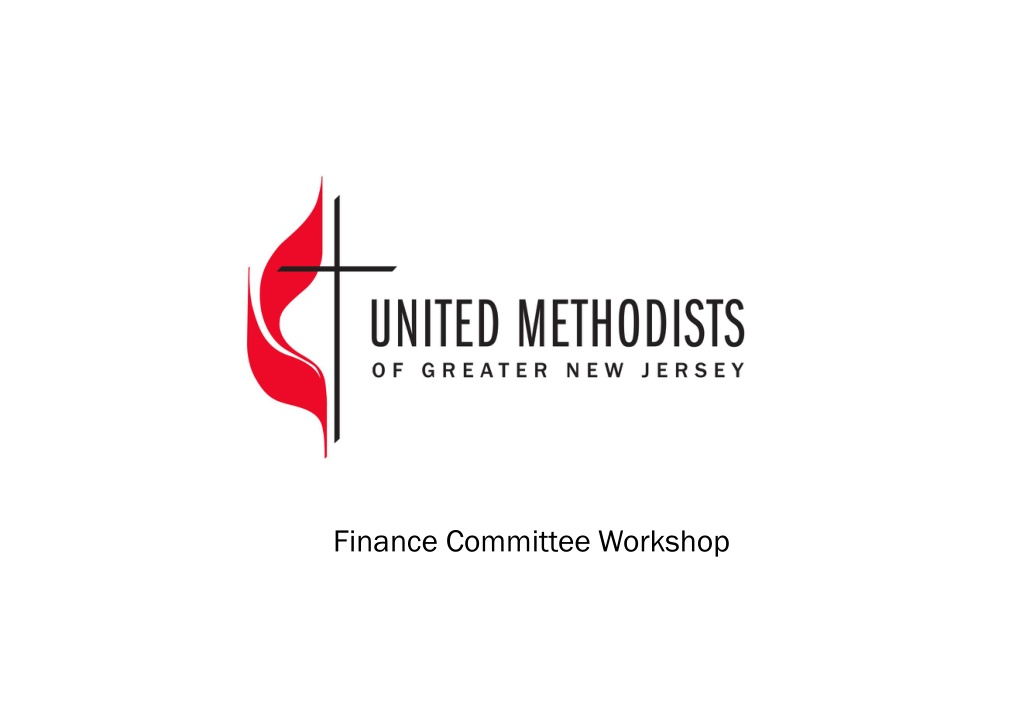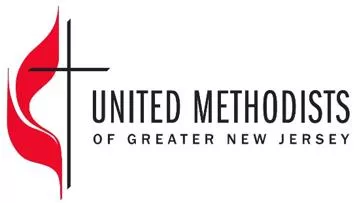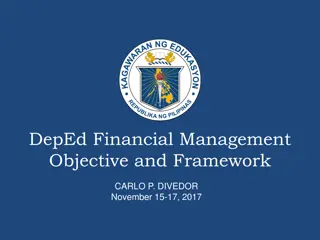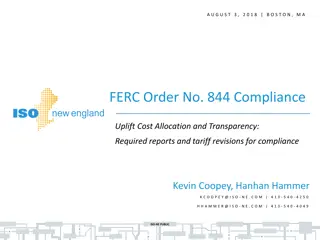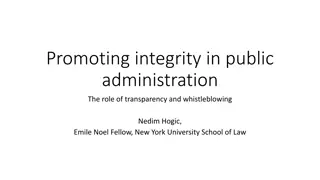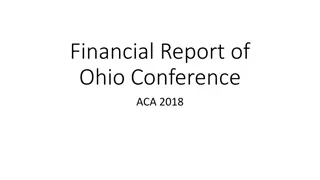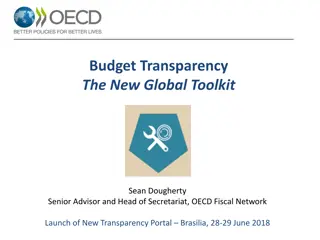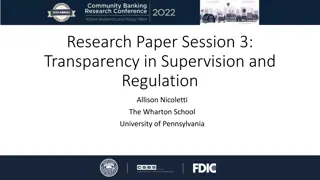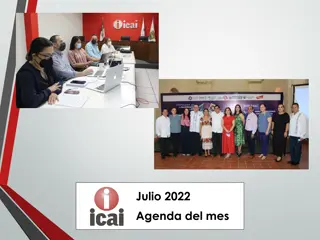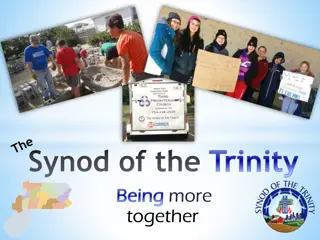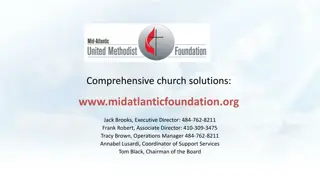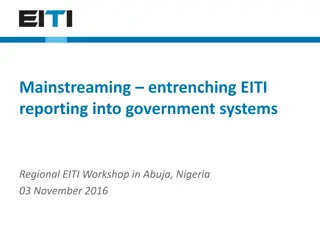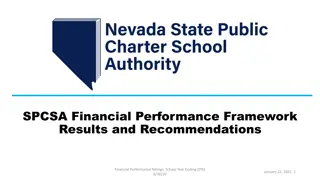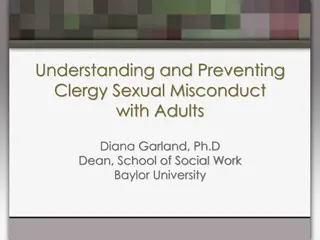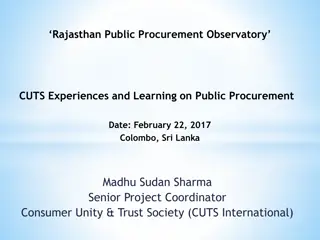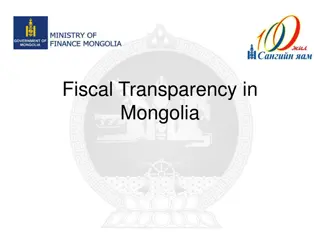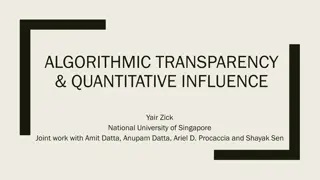Financial Transparency & Vital Congregations
Learn about the essential characteristics of financially vital congregations, including financial transparency, missional budgeting, and best practices. Explore the importance of sharing clear financial reports, implementing internal controls, and conducting audits. Understand the significance of statements of financial position, assets, liabilities, and more in ensuring financial health and sustainability.
Download Presentation

Please find below an Image/Link to download the presentation.
The content on the website is provided AS IS for your information and personal use only. It may not be sold, licensed, or shared on other websites without obtaining consent from the author.If you encounter any issues during the download, it is possible that the publisher has removed the file from their server.
You are allowed to download the files provided on this website for personal or commercial use, subject to the condition that they are used lawfully. All files are the property of their respective owners.
The content on the website is provided AS IS for your information and personal use only. It may not be sold, licensed, or shared on other websites without obtaining consent from the author.
E N D
Presentation Transcript
Characteristics of Financially Vital Congregations * 2 1. Financial Transparency A. Sharing clear, easy-to-understand financial reports with members B. Implementing a strong system of internal controls C. Providing for an annual audit of the financial reports 2. Missional Budgeting and Fundraising A. Facilitate the congregation-wide activity of discerning, planning and budgeting for God s mission 3. Best Practices A. Engage in practices that ensure their current financial health and long-term sustainability * Source: UMC Guidelines, Finance: Handling God s Money in the Church
Financial Transparency Financial Reports 3 1. Statement of Financial Position (balance sheet) Reflects the overall financial position of the organization at a given moment in time. It shows the accumulated results of all the individual years of your organization s operations put together. Assets = what you have or what you are owed Liabilities = what you owe Net Assets = what s left (Assets Liabilities) Unrestricted can be used for operating expenses or any other purpose Restricted designated to a specific program/project (examples: Mission Fund or Youth Ministry fund)
Financial Transparency Financial Reports (continued) 4 1. Statement of Financial Position (balance sheet) Assets examples and what to look for and/or ask: Cash do I have enough to pay the bills? Is it properly invested to maximize interest? Have we protected restricted funds? Is the balance increasing or decreasing? Accounts Receivable (money owed to us) are we collecting on a timely basis? Are there any that will never be paid? Do we have an allowance for doubtful accounts (an estimate of those that will not be paid)? Fixed Assets (Land, buildings & equipment) have we invested enough or too much?
Financial Transparency Financial Reports (continued) 5 1. Statement of Financial Position (balance sheet) Liabilities examples and what to look for and/or ask: Accounts payable (unpaid bills to vendors) / Accrued expenses (usually estimated expense not yet invoiced/paid) are we paying our vendors timely? Do we have enough cash to pay? Loans do we have the means to pay over time?
Financial Transparency Financial Reports (continued) 6 2. Statement of Activity (profit & loss statement) Shows the organization s revenue and expenses for a specific period of time. The report reflects the changes to an organization s net assets resulting from income and expenses that occur during the current period. Revenue less expenses = change in net assets Revenue greater than expenses = Surplus (profit) Revenue less than expenses = Deficit (loss) Report should include comparison to prior year and budget to monitor trends and risks/opportunities vs. budget Utilizing an accounting software system, such as QuickBooks, will facilitate maintaining accurate financial records and generating financial reports
Financial Transparency Financial Reports (continued) 7 Statement of Financial Position (Example) Assets Cash and Cash Equivalents Pledge receivables Pledge allowance account Other receivables Land, Buildings and Equipment Depreciation - Buildings and Equipment Total 306,201 181,003 (45,000) 603,589 3,845,300 ($1,698,329) Total Assets 3,192,765 ( A ) Liabilities and Net Assets Liabilities Accounts Payable and Accrued Expenses Loans 23,053 539,691 Total Liabilities 562,744 ( B ) Unrestricted Net Assets 2,495,272 ( C ) * Temporarily Restricted Net Assets Mission Fund Youth Ministry Fund Total Temporarily Restricted Net Assets $120,577 $14,172 134,749 ( D ) Total Net Assets ( A - B ) 2,630,021 ( C ) + ( D ) = ( E ) Total Liabilities and Net Assets 3,192,765 ( B ) + ( E ) = ( A ) * Details in Statement of Activity
Financial Transparency Financial Reports (continued) 8 Statement of Activity (Example 1) Full Year Actual Full Year Budget Variance to Budget Prior Year Actual Variance to PY Revenue: Pledges Non Pledge Regulars Loose plate / Visitor Donations Special Offerings Facility Rent Fund Raising Misc. Other Income Interest Income Total Revenue: 256,100 86,167 17,421 3,273 10,000 13,380 2,015 11,772 400,128 ( A ) - - - - Expenses: Staff Salary & related Office Supplies Office Equipment Other Administration Missions/Outreach Property Insurance & Maintenance Apportionments Total Expenses: Change in Net Assets 203,881 17,214 9,401 13,426 35,732 74,635 18,602 372,891 27,237 ( B ) ( A ) - ( B ) = ( C ) - - - - Opening Balance Closing Balance 2,468,035 2,495,272 ( D ) ( C ) + ( D ) * * Closing balance = Unrestricted Assets on Statement of Financial Position
UMC OF HO+A1:C21PE FINANCIAL STATEMENT FOR YEAR 2020 JANUARY 2020 BUDGET FOR 2020 Opening Balance DISBURSEMENTS Ministerial Support Pastor Compensation Reimbursable Expense Medical Insurance Pension Fund GNJ Conference Clergy Support Administration World Services Ministerial Education Education Staff Secretarial Support Organist Sexton Soc. Sec/Tax Withh Workers Compensation Program Expense Educational Materials Finance Worship/Music Witness Youth Nurture Outreach Office Supplies Office Machines Miscellaneous Church Building Gas Electricity Water Telephone Insurance Building Maintenance Grounds Maintenance Other Parsonage Expense Gas Fuel Electricity Water Telephone/TV Repairs/Maintenance Total Operating Expenses Capital Expenditure FUND ACCOUNT TOTAL EXPENSES Financial Transparency Financial Reports (continued) 9 Statement of Activity (Example 2) RECEIPTS Pledges Fund Raising Special Offering Donations for Ch Use Designated Funds Transfers Other TOTAL RECEIPTS Closing Balance
Financial Transparency Internal Controls 10 Strong internal controls do not suggest a lack of trust of volunteers and church employees; they serve to shield employees and volunteers from false accusations as well as temptation, and they protect and honor the gifts of donors. * 1. Segregation of Duties: Prevents a single person from perpetrating fraud Separates income and expense sides of the church Income role of Financial Secretary Expenses role of the Treasurer Financial Secretary and Treasurer must be separate, unrelated people Offerings should be counted by two, unrelated people Keep the following tasks separate: Approve payments Signing of checks Bank reconciliations Example: If the Treasurer is authorized to sign checks, someone else must approve the bill for payment * Source: UMC Guidelines, Finance: Handling God s Money in the Church
Financial Transparency Internal Controls (continued) 11 Strong internal controls do not suggest a lack of trust of volunteers and church employees; they serve to shield employees and volunteers from false accusations as well as temptation, and they protect and honor the gifts of donors. * 2. Physically securing assets: Keep the offering securely locked between collection and deposit Promptly deposit funds. Funds should not be taken home; use a night-drop Maintain bonding on church members handling money (covered by dishonesty coverage included in Church Mutual insurance). Limit distribution of keys and security codes; maintain a log of who has access 3. Implement authorization procedures identifying who has the right to perform certain functions, such as making purchases, transferring cash between accounts, etc. 4. Document financial transactions: Support each check issued with written documentation Vendor invoices should be approved via signature by the ordering party Count offering using a formatted count sheet and have two counters sign the sheet * Source: UMC Guidelines, Finance: Handling God s Money in the Church
Financial Transparency Internal Controls (continued) 12 Strong internal controls do not suggest a lack of trust of volunteers and church employees; they serve to shield employees and volunteers from false accusations as well as temptation, and they protect and honor the gifts of donors. * 5. Reconciliations Bank statements should be reconciled to the accounting records on a monthly basis by an individual that does not have signing authority on the accounts Reconcile offering counter sheets to the deposit slip and bank statements (by someone independent of the count) Provide donors with quarterly giving statements; donors should be encouraged to reconcile to their records. 6. Train volunteers and employees Provide detailed job descriptions for employees and committee members Teach ushers ow to take the offering and what to do with it Train counters to compare envelopes with content, preparing deposit slips and taking deposit to the bank Instruct volunteers working on fundraising events how to handle cash collected and paid out for the event * Source: UMC Guidelines, Finance: Handling God s Money in the Church
Financial Transparency Internal Controls (continued) 13 Strong internal controls do not suggest a lack of trust of volunteers and church employees; they serve to shield employees and volunteers from false accusations as well as temptation, and they protect and honor the gifts of donors. * Book of Discipline, 258.4c: The committee on finance should develop written financial policies to document the internal controls of the local church. These policies should be reviewed for adequacy and effectiveness annually by the committee on finance and submitted as a report to the charge conference. * Source: UMC Guidelines, Finance: Handling God s Money in the Church
Financial Transparency Annual Audit 14 Book of Discipline, 258.4d: The committee on finance shall make provisions for an annual audit of the financial statements of the local church and all its organizations and accounts. The committee shall make a full and complete report to the annual charge conference. 1. GCFA publishes the Local Church Audit Guide https://gcfa.org/media/2571/local-church-audit-guide-february-2021.pdf 2. Does not need to a Certified Public Accountant (CPA); needs to be an independent, not related to any of the financial positions or the pastor 3. Intended to be a process that provides reasonable assurance that good stewardship is practiced handling and accounting for funds and other assets of the church. 4. Audit includes: Financial statements of the church All the organizations and accounts of the church (operating account, trustees, pre-school, brokerage accounts, etc.) Internal controls of the church 5. Audit report provide to District Superintendent at time of Charge Conference
Financial Transparency Annual Audit (continued) 15 Why do an audit? 1. The book of discipline requires it! 2. To protect the people of the church elects to offices of financial responsibility from unwarranted charges of careless or improper handling of funds 3. To build trust and confidence with the financial supporters of the church in the way their money is being accounted for 4. To set habits of fiscal responsibility that continue with turnover in personnel 5. To ensure that gifts made to the church with special conditions attached (restricted funds) are consistently administered in accordance with the donor s instructions 6. To provide checks and balances for monies received and disbursed 7. NOT a symbol of distrust. Rather a mark of responsibility, good stewardship for all to see and a message to donors that you care about their gifts.
Missional Budgeting 16 1. Key component of a vital congregation Facilitates projection of income and expenses Provides benchmark to measure progress on goals Presents a snapshot of financial matters to 2. Prepared annually Responsibility of the finance committee with input from church council, committees and possibly the entire congregation (committee may solicit feedback rather than a secretive, behind-closed-doors manner) Seeks to develop stewards rather than donors Should reflect all income and expenses 3. Report progress periodically to congregation to help strengthen stewardship efforts; some consider lack of reporting to be a drag on efforts to promote giving 4. Be flexible to adapt & react to new information that arises during the year A budget is a point in time based on best available information at the time For example, an unexpected major repair may force you to shift money from another budgeted expense to offset the overage
Missional Budgeting (continued) 17 Budget Process: 1. Mission First a mission statement declares the priorities of the church 2. Discern and set goals & strategies Pastor leads a cross-section of congregation to discern on God s plans for the church this coming year Set SMART goals (focus on one big idea; two to three at most) o Specific what do you want to do? o Measurable how will you know when you reached it? o Achievable Is it in your power to accomplish? o Realistic can you realistically achieve it? o Time-bound when exactly do you want to accomplish it? o Develop strategies to achieve the goals 3. Budget align spending to mission & goals; committees provide description of how purpose of spend aligns Be realistic in projections of income; set a balanced budget of expenses vs. income Consider current trend, known one-time items (plus/minus) and goals or other changes in circumstances that will impact trend (simply comparing to prior year is insufficient)
Best Practices * 18 1. Place the mission and interest of the church above personal interests 2. Understand the connectional nature of apportionments 3. Honoring donor restrictions 4. Establish and follow a gift acceptance policy 5. Manage risk through insurance and training 6. Understand and comply with all laws and regulations * Source: UMC Guidelines, Finance: Handling God s Money in the Church
19 APPENDIX JOB DESCRIPTIONS
Finance Committee 20 Role: An effective finance team proposes a budget, then raises, manages, and distributes the financial resources to support & strengthen the mission & ministry of the congregation. Qualifications: Ability to listen to & communicate with people of all ages who have ideas about the mission and ministry of the congregation Skills with financial budgetary matters along with understanding of Biblical stewardship and management of the resources God provides. Structure: Comprised of a chairperson, pastor, lay member of annual conference, chairperson of church council, chairperson or rep. from staff-parish committee, a representative of the trustees, lay leader, financial secretary, treasurer and others determined by the charge conference. Responsibilities: Compile annual budget to support mission and vision of the church Submit budget to church leadership for review & adoption Provide reports that show how the church is doing vs. budget Develop & implement plans to raise sufficient income to support the approved budget Establish written financial policies & procedures for internal controls; assess effectiveness annually Recommend proper depositories for funds Arrange for annual audit of financial records of church & all its organizations and accounts; provide report to the charge conference
Treasurer 21 Role: Disburses funds in a responsible and timely manner with funds identified and bills paid when due, as directed by the policy and procedures. Qualifications: Demonstrate skills and interest in financial matters Can keep detailed, accurate records and maintain appropriate confidentiality Understand biblical stewardship and management of resources that God provides Responsibilities: Disburses all money contributed to the local church budget, keeping accurate records of how money is spent Utilize an accounting software (such as QuickBooks) or, at a minimum, a spreadsheet Manages disbursement of funds according to the policy & procedures established by the committee on Finance and Staff Parish Relations Committee (SPRC). This includes: o Maintaining compliance with all disciplinary requirements and applicable governmental tax guidelines. o Ensuring restricted funds are used only as directed by donors Prepares and disburses payroll checks (or direct deposit) o Prepares and files all payroll-related tax returns (941 s, W2 s, 1099 s, etc.) Works with the Financial Secretary to reconcile the records and keep records in good order for an annual audit Works with the Financial Secretary and chair of the committee on finance to make regular financial reports to the committee on finance, church council, and the charge conference Works with the committee on finance and SPRC to establish policy & procedures for the authorization and payment of bills, investment of funds and remittance of offerings
Financial Secretary 22 Role: Receives, records, & deposits funds in timely, thorough & confidential manner. Works with Treasurer & Finance Committee to develop policies & procedures to ensure funds are available to support the ministry of the congregation. Qualifications: Skills & interest in financial record keeping Can keep detailed, accurate records & maintain appropriate confidentiality Ability to work with individuals & ministry teams. Skills in identifying new revenue sources along with an understanding of biblical stewardship & management of all resources that God provides. Responsibilities: Supervise the offering count and deposits money as soon as possible after it is received Works according to policy & procedure established by Finance Committee to receive funds, count & record them, & report them to the Treasurer and Finance Committee Maintains detailed, accurate records of how much money is contributed and by whom Reconciles records against those of the Treasurer and keeps records in good order for audit Arranges for collecting offerings received during worship services & other church gatherings making certain that more than one person (unrelated) is involved in collecting & counting money Provide donors, at least quarterly, a statement of giving
23 APPENDIX Shared Ministry & Billings
24 Shared Ministry The local church Apportionment is determined as a percentage of the church s shared ministry base. The percentage is set at 15.2% for the year 2022 (updated/approved annually by Council of Finance & Administration) The baseis the total of a congregation s expenses including lines 41a-47 of Table II of the local church statistical report plus: The billed amounts for the prior year s Comprehensive Protection Plan (CPP), Clergy Retirement Security Program (CRSP), Health Insurance, Property Insurance and Workers Compensation.
25 Shared Ministry Shared Ministry provides support for the Conference Administration and World Mission expenses. The Conference s Shared ministry is made up of the apportionment from each local church. Thus, Shared Ministry makes us (UMC) a Connectional church because our shared mission is supported by the work we do together to support our Conference and the global church.
Shared Ministry Formula Shared Ministry Formula Calculation Example Calculation Example
27 Other Billings Include Other Billings Include Pastor Benefits: Clergy Retirement Security Program (CRSP) Comprehensive Protection Plan (CPP) Health Insurance Contributions Staff Benefits: Workers Compensation Church Insurance
